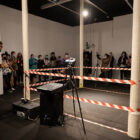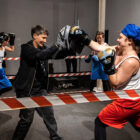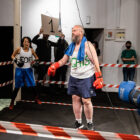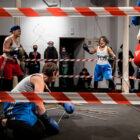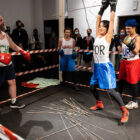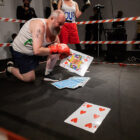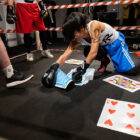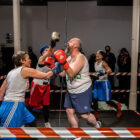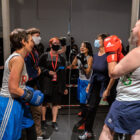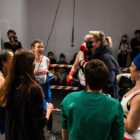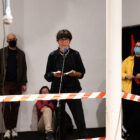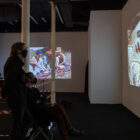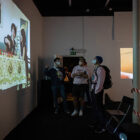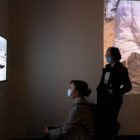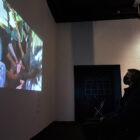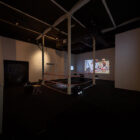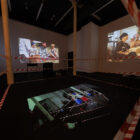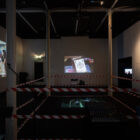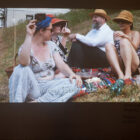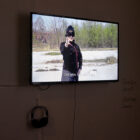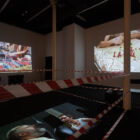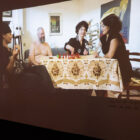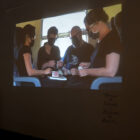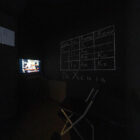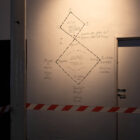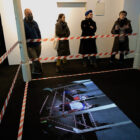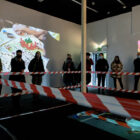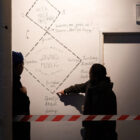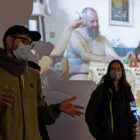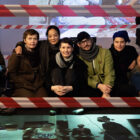27th International Festival of Contemporary Arts – City of Women
Dr Xenia: The Fourth Corner – Rights for Our Fights
Exhibition
2 – 28 October 2021
Alkatraz Gallery, AKC Metelkova mesto, Ljubljana
Festival and exhibition opening with performance by Dr. Xenia – Rights for Our Fights: Saturday, 2 October 2021, at 7 pm
Curated by Vesna Bukovec, Ana Grobler and Sebastian Krawczyk
A guided tour of the exhibition with Andreja Džakušič, Simon Macuh, Keiko Miyazaki and Iva Tratnik will take place on 12 October at 5pm in both the Slovenian and English language.
Alkatraz Gallery opening hours: Monday – Friday, 11am – 7pm.
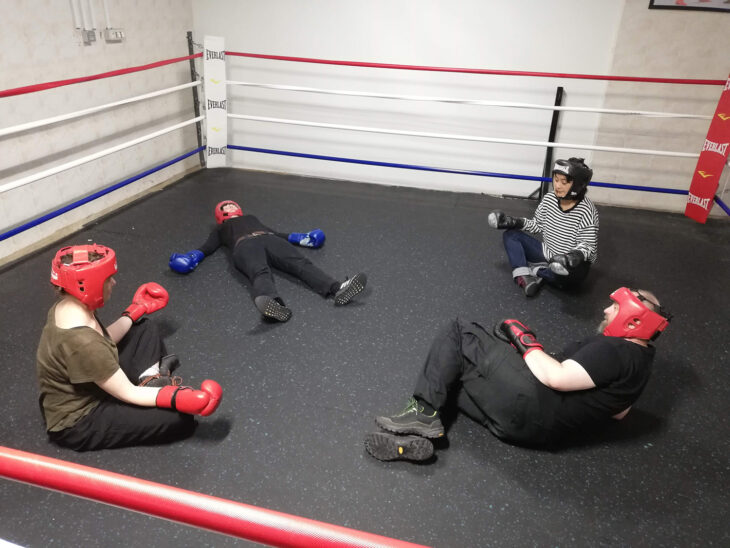
ABOUT THE EXHIBITION
Dr. Xenia is a newly formed common multi-gendered entity. Xe consists of an intertwinement of four people (the artists Andreja Džakušič, Keiko Miyazaki, Iva Tratnik, and Simon Macuh), who in the past participated in various mutual connections, but never in such a form. Dr. Xenia is thus a middle-aged collective person, who unites different identities. Through education, upbringing, and work xe has formed into an active, even activist persona, who does not believe that the world can be changed, but who wants to do just that. Xe describes xirself as an ‘ethical, collective body’, which means that xe has to constantly strive for xir own tolerance of all xirs components, statements, and actions. Through the creative process, xe attempts to emancipate xirself first and then include also others as active spectators in it. In xir performative actions, xe thoughtfully employs simple humorous mechanisms, by means of which xe reflects and at the same time subverts socially established patterns of behaviour. Through xir works rich in meanings and associations, xe invites viewers to active interpretation and joint debate, though which layers of meanings are revealed. In Dr Xenia’s words, xir aesthetics is relational in Rancier’s sense, as xe sees its public as active, thinking subjects, rather than passive consumers of simulacra of spectacle.
In addition to new works, the exhibition provides an archival overview of joint public actions and performances the artists have performed in the past ten years in the framework of various mutual collaborations with such names as SIVA, IvAn, IvAnKe, and AnKo. The themes of works vary according to participants, but what they all have in common is the exploration of everyday things and issues, from clothing to food and menstruation. The archive offers an insight into the past artistic practice and is an introduction into new works created for the present exhibition.
The title of the exhibition derives from a well-known Slovenian proverb[1], which reflects the patriarchal distribution of roles in a domestic household. The proverbial three corners of the house represent the home — an intimate space that is supposed to be separate from the public life. Nowadays, even more so, as it has also become a place of forced isolation for everyone determined by governmental measures. Dr. Xenia questions this patriarchal assumption of the home, and through the creative process, xe wants to change ingrained sexual and social roles. Xe therefore takes the dichotomies as a starting point for the subversion of roles: female/male, intimate/public, manifest/latent, domestic/foreign.
The word play from the second part of the title refers to historical efforts of self-organized collective anti-fascist, feminist, working, migrant, minority and LGBTQ+ struggles for rights. In the light of current governmental restrictions and limitations of protests, which are part of constitutionally guaranteed rights, the title should be understood predominantly as an affirmation of constitutional rights and a call for collective activity, activation of community, and perseverance in pursuit of change.
When thinking about fights and rights, Dr Xenia stumbles upon a question of social power and potency as its manifestation. Xe takes the cynical motto ‘everything is a game’ of those in positions of power literally, and appropriates the game as its modus operandi, in order to alert about the difference between the abuse of power and emancipatory empowerment. In doing this, xe does not overlook the fact that children’s play is also a way of socialization – getting to know and accepting established social rules of behaviour.
Four performances of dr. Xenia are based on well-known (social) games, which in the present version, are played according to new rules. Each performance fills its metaphoric corner of the gallery, which thus becomes the ‘house’ of fights for rights. The performance Stealing Land Dr Xenia performs on the land of the former Rakuš mill in Celje, a textbook example of capital appetites for plots in good locations, which evict ideas of non-profit spaces for culture intended for common and public good. The fight for territory begins and ends with incantations of masked performers dressed in black business attires: ‘I’m stealing, you’re stealing, we’re all stealing.’
In the performance The House of Cards, Dr Xenia does not travel north or west by train, but in a south-easterly direction. On the route that led to Kumrovec[2] in the previous country, but ends at the last station in front of the Croatian border in the new country, it tries to make a house out of cards. The impossible task is reminiscent of the inability to create safe life and home, which constantly elude refugees and migrants, as well as precarious workers of all ages, including cultural workers. At the end of the road, Dr Xenia faces harsh reality that prevents free movement, the horrifying symptom of which is barbed wire.
Man, Don’t Get Angry is first and foremost a feminist response to the familiar image of (dressed) Marcel Duchamp and (naked) Eva Babitz’s chess game from 1963. It is also a reference to the performance Mojca ärgere dich nicht[3], which was performed by Petja Grafenauer, Zoran Srdić Janežič, and Simon Macuh at the Red Dawn festival with the aim of defending the use of nudity in works of art. Here, next to the dressed women, there is a half-naked man, who does not get to make a move during the game. Play figures in the shape of red erected and green limp penises humorously allude to the generally accepted perception of potency as a symbol of power, which serves to exploit others. The performance conveys rich associations and shows that the mere exchange of power relations among genders in society when all the other relationships remain unchanged and, moreover, still based on capitalistic order, is by no means a solution.
The performance Fart Roulette is actually a picnic on the grass, which can be reminiscent of Manet’s famous painting, although this time, everyone present is dressed. The title refers to Russian roulette, and the authors shoot farts instead of bullets. The parody deals with a serious topic of environmental pollution and its far-reaching consequences. Artists in Celje have been warning about local polluters (Cinkarna Celje and other industries) for a long time, but those responsible do not take them seriously. They are said to be ‘farting ideas again’ and Dr Xenia took that literally.
Relaxed atmosphere of scenes we see in performances evokes ambivalent feelings in the context of the seriousness of the theme. This is another dichotomy of Dr Xenia. Faced with a question of how to address big stories of contemporary society from the position of powerlessness of the artistic subject, xe decides to perform failed attempts to change them: the house of cards is constantly collapsing, no one smells farts, even the board game we watch gives the impression of rotation in a meaningless circle. Otherwise, paradoxically, it is precisely this strategy of constant failure that removes the compulsion of necessity to achieve tangible results. The humour that is released at the same time has a subversive potential, as it brings creative reaction to the initial situation, moves it in the direction of the visible, and thus also problematizes it.
All the listed performances were performed without an audience and recorded in a video. The fifth performance entitled Rights for Our Fights shall be performed by Dr Xenia in front of an audience at the opening of the exhibition and festival The City of Women in the Alkatraz Gallery. Like the first four, the last performance defines the space: the four pillars in the centre of the gallery mark the four corners and form a boxing ring that becomes the scene of the fights. Whether it will be the fights with the audience, with xirself, with the system, or with something else, will be known soon. But it is already clear that in xir games Dr Xenia invites viewers to think and has fun while subverting expected rules.
[1] Literal translation: “The wife supports three corners of the house (the husband only one.)
[2] Kumrovec is a village and municipality in Croatia. It is known as the birth place of the President of Socialist Federal Republic of Yugoslavia, Josip Broz Tito (1892—1980). It used to be an important socialist destination of pilgrimage, which turned into a tourist one, but now the route is practically blind, as the train has to return the same way when it reaches the border.
[3] Mojca, ne jezi se (Mojca ärgere dich nicht), 2013
Exhibition info (pdf)
WORKS AT THE EXHIBITION
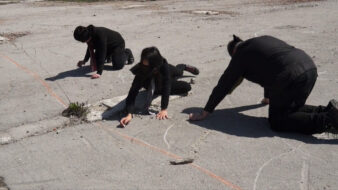
video performance, 2021, 7′ 15″
camera: Mihaela Žveglič, editing: Keiko Miyazaki
» video
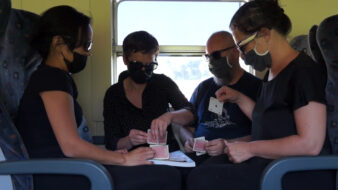
video performance, 2021, 6′ 45″
camera: Dr. Xenia, editing: Keiko Miyazaki
» video
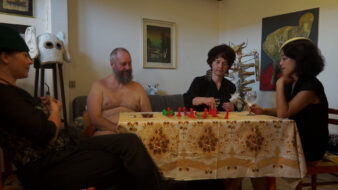
video performance, 2021, 2021, 19′ 32″
camera: Simon Macuh, Keiko Miyazaki, editing: Keiko Miyazaki, music: La Traviata (Giuseppe Verdi), Don Pasquale (Gaetano Donizetti), L’elisir D’amore: Act II: Una Furtiva Lagrima (Gaetano Donizetti), The Magic Flute KV 620: Act II (Wolfgang Amadeus Mozart), Cosi Fan Tutte, K. 588: “Una Donna Quindici Anni” (Wolfgang Amadeus Mozart), The Barber of Seville: Una Voce Poco Fa (Gioacchino Rossini)
» video
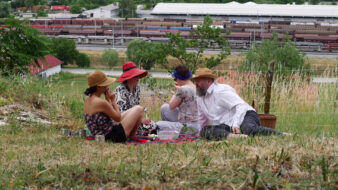
video performance, 2021, 6′ 39″
camera: Simon Macuh, Keiko Miyazaki, editing: Keiko Miyazaki
» video
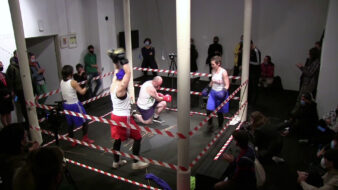
recording of the performance, 2021, 11′ 12″
camera: Dr. Xenia, Mihaela Žveglič, editing: Keiko Miyazaki
» video
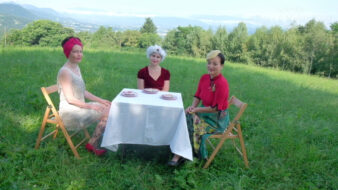
2021, 22′ 41″
SIVA, IvAn, IvAnKe, AnKo – SIVA, IvAn, IvAnKe, AnKo – excerpts from previous projects
editing: Keiko Miyazaki
» video
BIOGRAPHIES
Dr. Xenia: (born: 1975*) is a new collective body of authors from Celje, Andreja Džakušič, Simon Macuha, Keiko Miyazaki and Iva Tratnik, who have realized the artistic groups SIVA, IvAn, IvAnKe and AnKo in various combinations in the last ten years.
*Calculated age of Dr. Xenia: (1971 + 1971 + 1978 + 1980) / 4 = 1975
| Andreja Džakušič | Simon Macuh | Keiko Miyazaki | Iva Tratnik | |
| SIVA | X | X | X | |
| IvAn | X | X | ||
| IvAnKe | X | X | X | |
| AnKo | X | X |
The groups SIVA, IvAn, IvAnKe, AnKo are different combinations of collaborations between Andreja Džakušič, Simon Macuh, Keiko Miyazaki and Iva Tratnik. Group names consist of the initial letters or syllables of the performers’ names. It all started in 2009 with attending art events, when they started dressing in the chosen colour. The first rounded and comprehensive presentation was the exhibition Clothes … Human at the Art Salon in Celje at the end of 2010. The contents and collaborations were following one another in very different ways. First it was SIVA.
Andreja Džakušič obtained her BA and MA at the Faculty of Arts and Design in Ljubljana. She studied at the Výtvarných umění High School in Bratislava, Slovakia, and at the Sztuk Pięknych Academy in Kraków, Poland. In 2004, she was on a working visit to Belfast. She is self-employed in culture as a performer, intermedia artist, and cultural educator. She uses different media: performance, photography, video, interactive installation; she is mainly involved in socially engaged art, community art, and art in public space. As a president, she is active in the Association of Fine Artists of Celje and organizes exhibitions, events and a festival of artistic actions in the public space Admission Free. She also works in various art groups, such as SIVA, Public readings, IvAn, IvAnKe, AnKo, dr. Xenia et al. She lives and works in Celje, organizes individual and group art projects, and participates in group exhibitions at home and abroad.
Simon Macuh completed his studies of philosophy at the Faculty of Arts in Ljubljana, and his studies of sculpture at the Academy of Fine Arts and Design in Ljubljana. Since 2011 he has been self-employed in culture and works in the fields of sculpture, performance, and intermedia art. He builds his work in such a way that he often derives from theory, which he uses as a mental and conceptual starting point, which he then translates into practice through artistic procedures. Both formally and contentwise, he is interested in social relations, so he often cooperates with other individuals or groups. Since 2009, he has been participating and co-creating the Admission Free festival in Celje. In Celje, he also participated in exhibitions at the Art Salon and the Gallery of Contemporary Art. His works are in the permanent collection of the Centre for Contemporary Art and in the collection of the Gallery of Savinja Fine Artists in Savin’s House in Žalec, and the video archive of the DIVA Station includes videos of the SIVA group, of which he is a member.
Keiko Miyazaki was born in Ehime, Japan, in 1978. After completing her BA and MA in fine arts at the University of Northumbria in England (2003), she moved to Slovenia. She continued her studies at the Academy of Fine Arts and Design in Ljubljana (2004), and the Academy of Fine Arts in Krakow, Poland (2005). Keiko Miyazaki’s work is based on the observation of European social patterns. Originating in Japan, she discovers new aspects of communication by connecting and integrating her surroundings. She received the Sakaide Art Grand Prix (1999), the Cosmos Cable TV Show Award (2005), and the Shikokuchūō City Cultural Contribution Award. Since 1998, she has been exhibiting her works in Slovenia and abroad. She lives and works in Slovenia.
Iva Tratnik received her MA in 2012 from the Academy of Fine Arts and Design in Ljubljana. She researches a variety of artistic practices, including textile collages, oil and acrylic canvases, sculpture, drawing, installations, and other site-specific interventions. In parallel, she also deals with performance, where she experiments with voice, movement, and mask. She works independently or in temporary collectives.
PHOTOGALLERY
Performance, exhibitoin and festival City of Women opening, 2 October 2021, photo: Nada Žgank
Exhibition view, photo: Nada Žgank
A guided tour of the exhibition with artists and curators, 12 October 2021, photo: Nada Žgank
MEDIA COVERAGE
- Andrea Zabric, Mesto žensk sedemindvajsetič, Kulturne novice, Radio Študent, 5. 10. 2021
- Kultura, RTV SLO, 4. 10. 2021
COLOPHON
Curatorial text: Vesna Bukovec, Ana Grobler, Sebastian Krawczyk
Proofreading: Neja Berlič
English translation: Ana Makuc
Co-production: Cultural and Arts Association KUD Mreža — Alkatraz Gallery, Centre for Contemporary Arts SCCA — Ljubljana, and City of Women.
Supported by: The Ministry of Culture of the Republic of Slovenia and the City of Ljubljana, Department of Culture.
Thanks to: Neja Berlič, Mojca Senegačnik, Mihaela Žveglič, Boxing Club Intercom Celje, Cona Institute, Forum Ljubljana, Škuc Gallery


